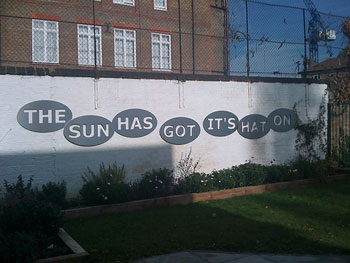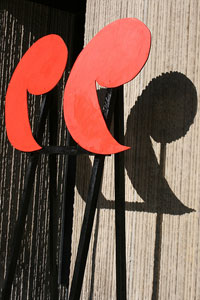
Source: day 198_blank, Ana C., Flickr
There are so many punctuation rules that it would be impossible to cover all of them in one lesson. In fact, there are so many punctuation rules that it would be nearly impossible to memorize all of them. As you did with capitalization and spelling, when you proofread your writing, you will need to rely on what you know, look up what you don’t know, and then devise ways to remember new information.
You already know that periods end sentences, question marks end questions, and quotation marks are used to indicate spoken words. In this section, you will concentrate on some of the more troublesome punctuation rules: when to use a semicolon, how to use apostrophes correctly, and what a comma can and cannot do in a sentence.
Comma or semicolon?
When you have written a compound sentence, the following rules apply:
- If the sentence has a conjunction (and, but, or, for, nor) between two independent clauses, insert a comma before the conjunction.
Example: The dog barked, and the cat hissed.
It rained, but it did not hail.
- If the sentence has a conjunction BUT the two clauses are closely linked and equal in weight (importance), you can replace the conjunction with a semicolon.
Example: The dog barked; the cat hissed.
It rained; it did not hail.

Source: Source: library157, Jisc, Flickr
Sometimes you may see a comma without a conjunction in a compound sentence. Your teacher might call this a “comma splice.”
Incorrect: The cat jumped, the bird flew away.
Correct: The cat jumped, and the bird flew away.
The cat jumped; the bird flew away.
You might remember it this way: A comma is “wimpy” punctuation. It is not strong enough to separate two complete thoughts (i.e., independent clauses). For the separation to be correct, a writer must use a semicolon instead or insert a conjunction after the comma.
See how you do on the following exercise. Determine whether each sentence is a correctly written sentence. Click “no errors” or “contains errors” after each sentence.

Commas splices are easy to correct when you are editing. Simply add a conjunction or remove the comma and separate the clauses with a semicolon. That way, you will avoid writing run-on sentences.

Source: Apostrophe, Renee Rosen-Wakeford, Flickr
Apostrophes
Probably the most common confusion with apostrophes is where to place them when you are showing possession. Here are three simple rules to follow.
- For all singular nouns, add an ‘s (e.g., whale’s splash or a book’s cover)
- For all plural nouns not ending in “s,” add ‘s (e.g., women’s clothing or children’s literature)
- For all plural nouns ending in “s,” add an apostrophe after the s (e.g., two dogs’ tags or both neighbors’ trees). (Note: If you are showing possession for a plural proper noun, you need to add some additional clues for your reader. We have a family with the last name of Jones. When we need to make that plural to refer to all of them, we write the 'Joneses'. When we need to make that possessive, we add the apostrophe at the end: Joneses' (e.g. the Joneses' dog).
 In the next set of examples, decide where the apostrophe should be placed in the underlined word. Copy and paste the list into the text editor and make your corrections. When you’re finished, check your understanding to see the correct responses.
In the next set of examples, decide where the apostrophe should be placed in the underlined word. Copy and paste the list into the text editor and make your corrections. When you’re finished, check your understanding to see the correct responses.- A hardware stores hours
- Billys bicycle
- Two boys lockers
- The mens department
- My four sisters bedrooms
- The rooms atmosphere
- The mices hideout
- Three deers habitat
- Two cars headlights
- Many spectators seats
Sample Responses:
- A hardware store’s hours (There is one hardware store.)
- Billy’s bicycle (There is only one boy named Billy.)
- Two boys’ lockers (There is more than one boy.)
- The men’s department (This plural noun doesn’t end in “s.”)
- My four sisters’ bedrooms (There is more than one sister.)
- The room’s atmosphere (There is only one room.)
- The mice’s hideout (This plural noun doesn’t end in “s.”)
- Three deer’s habitat (This plural noun doesn’t end in “s.”)
- Two cars’ headlights (There is more than one car.)
- Many spectators’ seats (There is more than one spectator.)
Keep in mind the three simple rules, and you should know where an apostrophe should be placed. When you are using your editing strategies, don’t forget to look at apostrophe placement.
Quotation marks vs. underlining (or italicizing)

Source: The “Library,” quinn.anya, Flickr
When you were in elementary school, the first thing you learned about quotation marks is that they always come in pairs and that they indicate spoken words. However, did you know that quotation marks can be used to indicate certain kinds of titles? Some titles use quotation marks, while other titles must be underlined (when handwritten) or italicized (when typed). How do you know when to use quotation marks and when to underline or italicize? Here is a list of which titles belong in which category.
| Quotation Marks | Underline/Italics |
|---|---|
| 1. Chapter titles | 1. Book titles |
| 2. Article names | 2. Magazine names |
| 3. Song titles | 3. Lengthy musical works |
| 4. Poems | 4. Long poems (such as epics) |
| 5. Newspaper articles | 5. Newspaper names |
| 6. Short stories | 6. Movie titles |
| 7. Essay titles | 7. Television shows |
Try the following exercise. Decide whether the title in each sentence should be italicized or have quotation marks placed around it. Click one choice to indicate the correct answer.

In essence, the thing to remember is that a book, newspaper, or movie is indicated by underlining or italicizing it; a part of a longer work, such as a chapter in a book or an article in a newspaper, is indicated with quotation marks. If you follow these guidelines, you will have an easier task when you are writing titles.